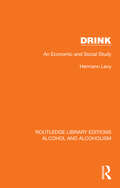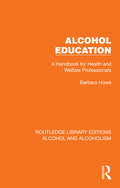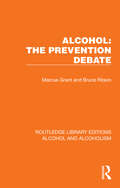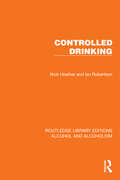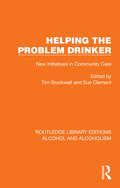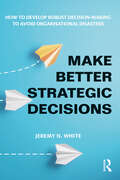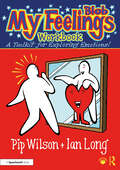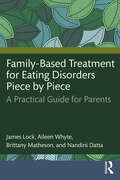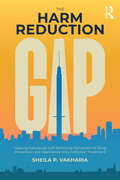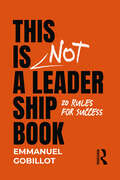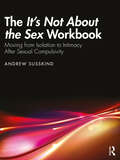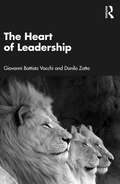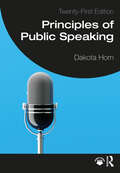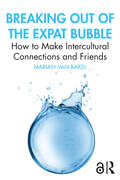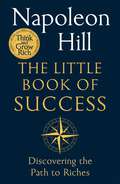- Table View
- List View
Drink: An Economic and Social Study (Routledge Library Editions: Alcohol and Alcoholism)
by Hermann LevyOriginally published in 1951, this title was the last book by Hermann Levy who died in 1949 before it was finished. Completed by his friend and fellow academic Rolf P. Lynton, this title looks alcohol as a drink, both economically and socially. Divided into three parts – in brief: what is the drink problem and what are its effects; how widespread is its incidence; and what can be done about it. Today it can be read and enjoyed in its historical context.
Alcohol Education: A Handbook for Health and Welfare Professionals (Routledge Library Editions: Alcohol and Alcoholism)
by Barbara HoweAlcohol education in the 1980s was receiving greater emphasis in the training and practice of a wide range of health and welfare professionals. As we became more aware of the risks associated with excessive drinking, this practical, straightforward guide, originally published in 1989, would have been essential reading for health and welfare workers who were keen to develop the alcohol education aspect of their work and enable their clients and patients to use alcohol in a harm-free way. Barbara Howe looks at alcohol education in context, clarifying its role and place in the day-to-day work of health and welfare professionals at the time. She also discusses common myths and misunderstandings about alcohol among professionals and their clients. She describes various approaches to alcohol education and includes a series of practical exercises for use with individuals and families, aimed at increasing professionals’ confidence and competence in broaching the subject of alcohol. Although working practices may have changed since first publication, much of this title will still be useful today.
Alcohol: The Prevention Debate (Routledge Library Editions: Alcohol and Alcoholism)
by Marcus Grant Bruce RitsonIn the early 1980s, emphasis had shifted from the treatment of alcohol problems to their prevention. Yet no clear integrated policy yet existed about how alcohol problems could best be prevented. Many different strategies were put forward as solutions but some were in competition with each other, while some were actually incompatible. Originally published in 1983, what this book does is to draw together a cross section of these different and competing voices so as to give a sense of the quality and direction of the great alcohol debate at the time. After setting into context some of the basic questions to do with the prevention of alcohol problems, the authors knit together and juxtapose short contributions from a very wide variety of experts from around the world. Clinicians, educators, sociologists, advertisers, marketing men, economists, philosophers, geneticists and international civil servants present different points of view on health education, the media, advertising, trade, the law, the environment and on the ethical basis of the debate itself. The authors bravely attempt to pull some general sense out of this profusion of what the way ahead is likely to be. It should be noted that this reissue very much reflects the context of the times in which it was written and that the contributors were participating in a debate where differences of opinion were actively encouraged.
Controlled Drinking (Routledge Library Editions: Alcohol and Alcoholism)
by Nick Heather Ian RobertsonOriginally published in 1981 and revised in 1983, Controlled Drinking was the first scholarly review of the literature on a controversial but increasingly practiced approach to the treatment of alcoholism. Nick Heather and Ian Robertson analyse all the pertinent questions that controlled drinking raises, starting with the need to examine the ‘disease conception’ of alcoholism and ‘total abstinence’ treatment. They look at the evidence indicating that some people, previously diagnosed as alcoholics, are able to return to normal, controlled patterns of drinking, and discuss therapies where controlled drinking is the treatment goal, fully reviewing the evidence for their success and failure. Concluding with a discussion of the theoretical and policy implications of controlled drinking, the authors recommend that the disease view of alcoholism be finally abandoned. For the revised paperback edition, as well as correcting and updating the text and references, the authors included an important postscript on the charges of falsification of evidence and their subsequent refutation which made up the Sobell affair. The wealth of other material presented in Controlled Drinking supports the authors’ conclusions even if the Sobells’ work were ignored. However, this revised edition was made more useful for student and professional readers by the postscript’s discussion of the controversy surrounding the most widely known and quoted controlled drinking trial at the time.
Helping the Problem Drinker: New Initiatives in Community Care (Routledge Library Editions: Alcohol and Alcoholism)
Originally published in 1987, Helping the Problem Drinker addressed the realisation that only a small proportion of problem drinkers ever contacted existing treatment agencies, and that therefore a more comprehensive community-oriented approach should be developed. This included training of primary care health workers and the development of multidisciplinary Community Alcohol Teams. At the time other community-based initiatives such as self-help groups for early problem drinkers and early intervention programmes in general practice and general hospitals, had been implemented. This book draws together what had been learned about these new developments, a number of which had now been evaluated. The book will still be of interest to all planners and professional staff concerned with alcohol problems: both specialists and non-specialists in general medicine, psychiatry, psychology and the social services.
Helping the Problem Drinker: New Initiatives in Community Care (Routledge Library Editions: Alcohol and Alcoholism)
by Tim StockwellOriginally published in 1987, Helping the Problem Drinker addressed the realisation that only a small proportion of problem drinkers ever contacted existing treatment agencies, and that therefore a more comprehensive community-oriented approach should be developed. This included training of primary care health workers and the development of multidisciplinary Community Alcohol Teams. At the time other community-based initiatives such as self-help groups for early problem drinkers and early intervention programmes in general practice and general hospitals, had been implemented. This book draws together what had been learned about these new developments, a number of which had now been evaluated. The book will still be of interest to all planners and professional staff concerned with alcohol problems: both specialists and non-specialists in general medicine, psychiatry, psychology and the social services.
Make Better Strategic Decisions: How to Develop Robust Decision-making to Avoid Organisational Disasters
by Jeremy N. WhiteEvery day we hear of serious errors of judgement that result in organisational disaster. Why do seemingly successful businesses, NGOs, or even political parties fall prey to irrevocable governance breakdowns or, worse still, criminal malpractice? By prompting readers to think deeply about strategic decision-making, human behaviour, and cognitive biases, this book offers a disciplined, objective, and thoughtful approach to making better decisions. Every strategic problem is fundamentally a journey into the unknown, which involves a unique combination of duration, scale, external and internal dynamics, and personal motivations. Rarely is a strategic decision solved by saying, ‘If a situation is A, then the solution is B.’ The book explores how to develop a strong foundation for problem resolving – rather than simplistic problem-solving – by strengthening competence so that decisions are made wisely. The case of Carillion plc, the second-largest construction group in the United Kingdom that went bankrupt in January 2018, is used to explore how a large and profitable company collapsed so dramatically when it was run by an experienced board and advised by three of the Big Four accounting firms. Professor Jeremy N. White presents a clear strategic toolkit for better strategic decision-making. This book will appeal to senior managers who are interested in techniques for making better strategic decisions. The lessons from the failure of Carillion plc are applicable to corporate leaders in addition to politicians and those who run not-for-profit organisations.
Make Better Strategic Decisions: How to Develop Robust Decision-making to Avoid Organisational Disasters
by Jeremy N. WhiteEvery day we hear of serious errors of judgement that result in organisational disaster. Why do seemingly successful businesses, NGOs, or even political parties fall prey to irrevocable governance breakdowns or, worse still, criminal malpractice? By prompting readers to think deeply about strategic decision-making, human behaviour, and cognitive biases, this book offers a disciplined, objective, and thoughtful approach to making better decisions. Every strategic problem is fundamentally a journey into the unknown, which involves a unique combination of duration, scale, external and internal dynamics, and personal motivations. Rarely is a strategic decision solved by saying, ‘If a situation is A, then the solution is B.’ The book explores how to develop a strong foundation for problem resolving – rather than simplistic problem-solving – by strengthening competence so that decisions are made wisely. The case of Carillion plc, the second-largest construction group in the United Kingdom that went bankrupt in January 2018, is used to explore how a large and profitable company collapsed so dramatically when it was run by an experienced board and advised by three of the Big Four accounting firms. Professor Jeremy N. White presents a clear strategic toolkit for better strategic decision-making. This book will appeal to senior managers who are interested in techniques for making better strategic decisions. The lessons from the failure of Carillion plc are applicable to corporate leaders in addition to politicians and those who run not-for-profit organisations.
My Blob Feelings Workbook: A Toolkit for Exploring Emotions! (Blobs)
by Pip Wilson Ian LongMy Blob Feelings Workbook provides the reader with a series of unique visual reflective exercises that help to reveal one’s own emotional portrait. Using a combination of Blob characters and open questions, the reader can gradually build up an image of themselves across a wide range of ‘who I am’ subjects and real-life scenarios.Packed with well-loved blob illustrations, this book includes a wealth of downloadable pages and will enable the individual to ‘draw’ a picture of themselves emotionally through the series of exercises. Sections covered include: My Charts My Feeling Scales My Scenarios Myself Scales Best used as a personal toolkit for self-awareness, this book is also a rich resource for professionals working in the field of feelings to use with their own clients. It is suitable for all ages from secondary school upwards and ideal for individuals, couples, groups and all who wish to go deeper in understanding their emotional strengths and areas for development.
My Blob Feelings Workbook: A Toolkit for Exploring Emotions! (Blobs)
by Pip Wilson Ian LongMy Blob Feelings Workbook provides the reader with a series of unique visual reflective exercises that help to reveal one’s own emotional portrait. Using a combination of Blob characters and open questions, the reader can gradually build up an image of themselves across a wide range of ‘who I am’ subjects and real-life scenarios.Packed with well-loved blob illustrations, this book includes a wealth of downloadable pages and will enable the individual to ‘draw’ a picture of themselves emotionally through the series of exercises. Sections covered include: My Charts My Feeling Scales My Scenarios Myself Scales Best used as a personal toolkit for self-awareness, this book is also a rich resource for professionals working in the field of feelings to use with their own clients. It is suitable for all ages from secondary school upwards and ideal for individuals, couples, groups and all who wish to go deeper in understanding their emotional strengths and areas for development.
Family-Based Treatment for Eating Disorders Piece by Piece: A Practical Guide for Parents
by James Lock Aileen Whyte Brittany Matheson Nandini DattaThe book illustrates how parents who are participating in family-based treatment (FBT) for their child's eating disorder (ED) may enhance their chances of achieving optimal outcomes for their child by more successfully navigating the challenges that often impede progress in treatment and recovery.The stance of the book is transdiagnostic, so that the information provided spans all ED diagnoses including anorexia nervosa (AN), bulimia nervosa (BN), binge eating disorder (BED), avoidant/restrictive food intake disorder (ARFID), and atypical ED presentations as well as conditions that fall outside current diagnostic criteria. This book aims to help parents identify how they can make the most out of FBT therapy no matter which ED symptoms their child experiences. Case vignettes across the diagnostic and clinical spectrum are used liberally throughout the book, not only to illustrate examples of some of the specific challenges families face, but to help parents normalize the emotions they may feel around their experience of trying to help their child and around their experience of participating in the FBT intervention itself. A respectful and supportive tone makes this resource accessible and jargon-free for parents, and provides useful information and approaches for psychologists, psychiatrists, social workers, and allied health practitioners who deliver FBT to young people and families.
Family-Based Treatment for Eating Disorders Piece by Piece: A Practical Guide for Parents
by James Lock Aileen Whyte Brittany Matheson Nandini DattaThe book illustrates how parents who are participating in family-based treatment (FBT) for their child's eating disorder (ED) may enhance their chances of achieving optimal outcomes for their child by more successfully navigating the challenges that often impede progress in treatment and recovery.The stance of the book is transdiagnostic, so that the information provided spans all ED diagnoses including anorexia nervosa (AN), bulimia nervosa (BN), binge eating disorder (BED), avoidant/restrictive food intake disorder (ARFID), and atypical ED presentations as well as conditions that fall outside current diagnostic criteria. This book aims to help parents identify how they can make the most out of FBT therapy no matter which ED symptoms their child experiences. Case vignettes across the diagnostic and clinical spectrum are used liberally throughout the book, not only to illustrate examples of some of the specific challenges families face, but to help parents normalize the emotions they may feel around their experience of trying to help their child and around their experience of participating in the FBT intervention itself. A respectful and supportive tone makes this resource accessible and jargon-free for parents, and provides useful information and approaches for psychologists, psychiatrists, social workers, and allied health practitioners who deliver FBT to young people and families.
The Harm Reduction Gap: Helping Individuals Left Behind by Conventional Drug Prevention and Abstinence-only Addiction Treatment
by Sheila P. VakhariaThis long-awaited book teaches how harm reduction can be a safety net for people with substance use disorders that our current addiction treatment rejects, abandons, and leaves behind. Harm reduction is an approach to helping people who engage in high-risk activities to develop the skills and strategies to keep them and their communities safe. This can include the provision of sterile equipment, low-threshold and low-barrier care, and the acceptance of non-abstinence goals in treatment. In this novel guide, Dr. Vakharia discusses the shortcomings of the dominant “Just Say No” drug prevention messages and abstinence-only treatment approaches, introduces harm reduction strategies and technologies borne from people who use drugs themselves, and suggests various policy options available as alternatives to the current policies that criminalize drugs, drug-using equipment, and the settings in which people use drugs. The final chapter calls on the reader to destigmatize drug use and support efforts to reform our drug policies. By highlighting the large gap in our current approach to substance use – the harm reduction gap – this book is the first step for those interested in learning more about the limitations of our current approach to drug use and how to support local efforts to ensure people who use drugs and their communities can stay safe.
The Harm Reduction Gap: Helping Individuals Left Behind by Conventional Drug Prevention and Abstinence-only Addiction Treatment
by Sheila P. VakhariaThis long-awaited book teaches how harm reduction can be a safety net for people with substance use disorders that our current addiction treatment rejects, abandons, and leaves behind. Harm reduction is an approach to helping people who engage in high-risk activities to develop the skills and strategies to keep them and their communities safe. This can include the provision of sterile equipment, low-threshold and low-barrier care, and the acceptance of non-abstinence goals in treatment. In this novel guide, Dr. Vakharia discusses the shortcomings of the dominant “Just Say No” drug prevention messages and abstinence-only treatment approaches, introduces harm reduction strategies and technologies borne from people who use drugs themselves, and suggests various policy options available as alternatives to the current policies that criminalize drugs, drug-using equipment, and the settings in which people use drugs. The final chapter calls on the reader to destigmatize drug use and support efforts to reform our drug policies. By highlighting the large gap in our current approach to substance use – the harm reduction gap – this book is the first step for those interested in learning more about the limitations of our current approach to drug use and how to support local efforts to ensure people who use drugs and their communities can stay safe.
This Is Not A Leadership Book: 20 Rules for Success
by Emmanuel GobillotPart leadership book, part business book and 100% true, this is like hearing a wise, honest, and humorous mentor finally tell you about the world of business as it is and how to find your place in it.Many leadership books are either shallow (focusing on only one element of leadership), narrow (examining leadership out of context), or biased (selling an idealised model). This book seeks simplicity without being simplistic and focuses on the reader in their context rather than describing other people’s leadership in theirs. It sets out 20 rules for success that draw on Emmanuel Gobillot’s 20 years of experience advising high- performing leaders. Each rule is presented in an engaging, instantly recognisable true story that helps current and aspiring leaders to look differently at their own situation.Best described as a leadership development programme, this book takes you on a fast-paced, three-step journey from what it takes to be a leader, to why you can be one, via how to succeed.
This Is Not A Leadership Book: 20 Rules for Success
by Emmanuel GobillotPart leadership book, part business book and 100% true, this is like hearing a wise, honest, and humorous mentor finally tell you about the world of business as it is and how to find your place in it.Many leadership books are either shallow (focusing on only one element of leadership), narrow (examining leadership out of context), or biased (selling an idealised model). This book seeks simplicity without being simplistic and focuses on the reader in their context rather than describing other people’s leadership in theirs. It sets out 20 rules for success that draw on Emmanuel Gobillot’s 20 years of experience advising high- performing leaders. Each rule is presented in an engaging, instantly recognisable true story that helps current and aspiring leaders to look differently at their own situation.Best described as a leadership development programme, this book takes you on a fast-paced, three-step journey from what it takes to be a leader, to why you can be one, via how to succeed.
The It’s Not About the Sex Workbook: Moving from Isolation to Intimacy After Sexual Compulsivity
by Andrew SusskindThis intimate guide offers readers step-by-step suggestions to build traction and create momentum in any stage of healing through illuminating case studies, memoir snapshots, as well as applicable action steps. The book presents a forward-thinking wellness model that takes the whole person into consideration rather than pathologizing or dwelling on compulsive behavior of the past. Each chapter includes a composite case study and a memoir snapshot to set the tone and illustrate themes to be explored. The studies and snapshots demonstrate the residual challenges and limitless opportunities facing those in long-term recovery from sexual compulsivity. Utilizing the tools of positive psychology, attachment theory, and nervous system regulation, readers are challenged to leverage their resilience and resourcefulness. Critical issues such as spirituality and mindfulness provide a purposeful soul-searching toward wellness and well-being. For use in conjunction with therapy, twelve-step groups or as a self-help workbook, this book focuses on the present and the future with an emphasis on the establishment of deeper connection and cultivating greater life fulfilment beyond compulsive sexual behavior.
The It’s Not About the Sex Workbook: Moving from Isolation to Intimacy After Sexual Compulsivity
by Andrew SusskindThis intimate guide offers readers step-by-step suggestions to build traction and create momentum in any stage of healing through illuminating case studies, memoir snapshots, as well as applicable action steps. The book presents a forward-thinking wellness model that takes the whole person into consideration rather than pathologizing or dwelling on compulsive behavior of the past. Each chapter includes a composite case study and a memoir snapshot to set the tone and illustrate themes to be explored. The studies and snapshots demonstrate the residual challenges and limitless opportunities facing those in long-term recovery from sexual compulsivity. Utilizing the tools of positive psychology, attachment theory, and nervous system regulation, readers are challenged to leverage their resilience and resourcefulness. Critical issues such as spirituality and mindfulness provide a purposeful soul-searching toward wellness and well-being. For use in conjunction with therapy, twelve-step groups or as a self-help workbook, this book focuses on the present and the future with an emphasis on the establishment of deeper connection and cultivating greater life fulfilment beyond compulsive sexual behavior.
The Heart of Leadership
by Giovanni Battista Vacchi Danilo ZattaSquarely aimed at leaders and aspiring leaders, The Heart of Leadership, written by two renowned management experts, presents practical examples and engaging insights to answer the key question of how to be a successful leader.This book reveals the key characteristics of a great leader and shows you how to develop the skills needed to motivate your team and overcome challenges. Leadership means successfully taking your place at the head of an enterprise and is both a shared journey and an adventure over the course of a career. Using an engaging and accessible style throughout, the book maps out how to achieve tangible results. It presents portrayals of some of history’s greatest leaders, from Gandhi to Steve Jobs, from Angela Merkel to Lisa Su, in order to inspire and help develop your own top leadership skills.This book is essential reading for CEOs, CFOs, HR managers, entrepreneurs, trainers, and those who are seeking a leadership position in an organization and want to understand how to succeed within it.
The Heart of Leadership
by Giovanni Battista Vacchi Danilo ZattaSquarely aimed at leaders and aspiring leaders, The Heart of Leadership, written by two renowned management experts, presents practical examples and engaging insights to answer the key question of how to be a successful leader.This book reveals the key characteristics of a great leader and shows you how to develop the skills needed to motivate your team and overcome challenges. Leadership means successfully taking your place at the head of an enterprise and is both a shared journey and an adventure over the course of a career. Using an engaging and accessible style throughout, the book maps out how to achieve tangible results. It presents portrayals of some of history’s greatest leaders, from Gandhi to Steve Jobs, from Angela Merkel to Lisa Su, in order to inspire and help develop your own top leadership skills.This book is essential reading for CEOs, CFOs, HR managers, entrepreneurs, trainers, and those who are seeking a leadership position in an organization and want to understand how to succeed within it.
Principles of Public Speaking
by Dakota HornNow in its 21st edition, this introductory public speaking textbook encourages the reader to see public speaking as a way to build community in today’s diverse world.Within a framework that emphasizes speaker responsibility, listening, and cultural awareness, this classic book uses examples from college, the workplace, and political and social communication to make the study of public speaking relevant, contemporary, and exciting. Balancing skills and theory, new author Dakota Horn provides expanded coverage of speaking anxiety and understanding and delivering digital presentations along with two new chapters on culture and diversity and diversifying speeches. Each chapter also contains in-class applied activities to support students' learning.This textbook is ideal for general courses on public speaking as well as specialized programs in business, management, political communication, and public affairs.An Instructor’s Manual featuring discussion questions and guides, exercises, quiz questions, and suggestions and resources for syllabus design as well as PowerPoint slides is available at https://www.routledge.com/9781032537634
Principles of Public Speaking
by Dakota HornNow in its 21st edition, this introductory public speaking textbook encourages the reader to see public speaking as a way to build community in today’s diverse world.Within a framework that emphasizes speaker responsibility, listening, and cultural awareness, this classic book uses examples from college, the workplace, and political and social communication to make the study of public speaking relevant, contemporary, and exciting. Balancing skills and theory, new author Dakota Horn provides expanded coverage of speaking anxiety and understanding and delivering digital presentations along with two new chapters on culture and diversity and diversifying speeches. Each chapter also contains in-class applied activities to support students' learning.This textbook is ideal for general courses on public speaking as well as specialized programs in business, management, political communication, and public affairs.An Instructor’s Manual featuring discussion questions and guides, exercises, quiz questions, and suggestions and resources for syllabus design as well as PowerPoint slides is available at https://www.routledge.com/9781032537634
Breaking out of the Expat Bubble: How to Make Intercultural Connections and Friends
by Marian van BakelMoving abroad means having to settle into a new host country. This book enables expats and those who support them to create intercultural connections and friendships both within and outside the workplace.Having left behind a large part of their social network, expats need to make local friends to really settle in. This book shows you how this works, and that breaking out of the expat bubble and making local friends helps you adjust and settle in the new place you call home. Organisations and societies should also support expats if they would like to retain this international talent. It is important to create the conditions for expats to build a social network, for example by connecting them with a local buddy. Learn more in this book about the advantages of such contact and how to set up and manage a buddy system to the benefit of both your expats and your organisation or community. The book is illustrated by many quotes from almost 20 years of research and features 11 real-world experiences of expats around the world. It also includes practical recommendations for expats, organisations and societies.An invaluable resource on creating more intercultural connections and friendships in the workplace and the local community, this book will be well placed in the hand luggage of expats – especially those who go without much organisational support – as well as on the desks of managers and HR professionals who would like to better support expats on this great adventure.
Breaking out of the Expat Bubble: How to Make Intercultural Connections and Friends
by Marian van BakelMoving abroad means having to settle into a new host country. This book enables expats and those who support them to create intercultural connections and friendships both within and outside the workplace.Having left behind a large part of their social network, expats need to make local friends to really settle in. This book shows you how this works, and that breaking out of the expat bubble and making local friends helps you adjust and settle in the new place you call home. Organisations and societies should also support expats if they would like to retain this international talent. It is important to create the conditions for expats to build a social network, for example by connecting them with a local buddy. Learn more in this book about the advantages of such contact and how to set up and manage a buddy system to the benefit of both your expats and your organisation or community. The book is illustrated by many quotes from almost 20 years of research and features 11 real-world experiences of expats around the world. It also includes practical recommendations for expats, organisations and societies.An invaluable resource on creating more intercultural connections and friendships in the workplace and the local community, this book will be well placed in the hand luggage of expats – especially those who go without much organisational support – as well as on the desks of managers and HR professionals who would like to better support expats on this great adventure.
The Little Book of Success: Discovering the Path to Riches
by Napoleon HillFrom the legendary author of Think and Grow Rich, The Little Book of Success is a collection of Napoleon Hill’s most inspiring and life changing wisdom on personal success.The writings and wisdom of Napoleon Hill have transformed millions of lives, making him one of the most influential writers on personal success and an incomparable bestseller. His invaluable classic, Think and Grow Rich, has guided more people to becoming millionaires and billionaires than any other book in history. Compiled by The Napoleon Hill Foundation, The Little Book of Success: Discovering the Path to Riches presents a curated collection of some of Napoleon Hill’s most significant teachings in one complete volume. Drawing on published as well as previously unpublished works by Hill, the book consists of Hill’s teachings presented in an accessible, bite-sized format.This collection is ideal for readers who are new to Hill’s work and are looking for an essential primer as well as devoted followers who want to revisit his most impactful works.Published elsewhere as Success: Discovering the Path to Riches.
